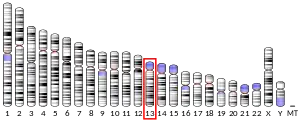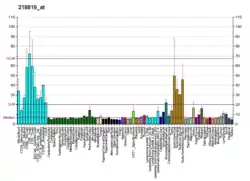INTS6
Integrator complex subunit 6 is a protein that in humans is encoded by the INTS6 gene.[5][6][7]
| INTS6 | |||||||||||||||||||||||||||||||||||||||||||||||||||
|---|---|---|---|---|---|---|---|---|---|---|---|---|---|---|---|---|---|---|---|---|---|---|---|---|---|---|---|---|---|---|---|---|---|---|---|---|---|---|---|---|---|---|---|---|---|---|---|---|---|---|---|
| Identifiers | |||||||||||||||||||||||||||||||||||||||||||||||||||
| Aliases | INTS6, DBI-1, DDX26, DDX26A, DICE1, HDB, INT6, Notchl2, integrator complex subunit 6 | ||||||||||||||||||||||||||||||||||||||||||||||||||
| External IDs | OMIM: 604331 MGI: 1202397 HomoloGene: 8121 GeneCards: INTS6 | ||||||||||||||||||||||||||||||||||||||||||||||||||
| |||||||||||||||||||||||||||||||||||||||||||||||||||
| |||||||||||||||||||||||||||||||||||||||||||||||||||
| |||||||||||||||||||||||||||||||||||||||||||||||||||
| |||||||||||||||||||||||||||||||||||||||||||||||||||
| |||||||||||||||||||||||||||||||||||||||||||||||||||
| Wikidata | |||||||||||||||||||||||||||||||||||||||||||||||||||
| |||||||||||||||||||||||||||||||||||||||||||||||||||
DEAD box proteins, characterized by the conserved motif Asp-Glu-Ala-Asp (DEAD), are putative RNA helicases. The protein encoded by this gene is a DEAD box protein that is part of a complex that interacts with the C-terminus of RNA polymerase II and is involved in 3' end processing of snRNAs. In addition, this gene is a candidate tumor suppressor and located in the critical region of loss of heterozygosity (LOH). Three transcript variants encoding two different isoforms have been found for this gene.[7]
References
- GRCh38: Ensembl release 89: ENSG00000102786 - Ensembl, May 2017
- GRCm38: Ensembl release 89: ENSMUSG00000035161 - Ensembl, May 2017
- "Human PubMed Reference:". National Center for Biotechnology Information, U.S. National Library of Medicine.
- "Mouse PubMed Reference:". National Center for Biotechnology Information, U.S. National Library of Medicine.
- Wieland I, Arden KC, Michels D, Klein-Hitpass L, Bohm M, Viars CS, Weidle UH (Oct 1999). "Isolation of DICE1: a gene frequently affected by LOH and downregulated in lung carcinomas". Oncogene. 18 (32): 4530–7. doi:10.1038/sj.onc.1202806. PMID 10467397.
- Baillat D, Hakimi MA, Naar AM, Shilatifard A, Cooch N, Shiekhattar R (Oct 2005). "Integrator, a multiprotein mediator of small nuclear RNA processing, associates with the C-terminal repeat of RNA polymerase II". Cell. 123 (2): 265–76. doi:10.1016/j.cell.2005.08.019. PMID 16239144.
- "Entrez Gene: INTS6 integrator complex subunit 6".
Further reading
- Buchsbaum S, Morris C, Bochard V, Jalinot P (2007). "Human INT6 interacts with MCM7 and regulates its stability during S phase of the cell cycle". Oncogene. 26 (35): 5132–44. doi:10.1038/sj.onc.1210314. PMID 17310990.
- Hernández M, Papadopoulos N, Almeida TA (2006). "Absence of mutations in DICE1/DDX26 gene in human cancer cell lines with frequent 13q14 deletions". Cancer Genet. Cytogenet. 163 (1): 91–2. doi:10.1016/j.cancergencyto.2005.04.014. PMID 16271964.
- Röpke A, Buhtz P, Böhm M, et al. (2005). "Promoter CpG hypermethylation and downregulation of DICE1 expression in prostate cancer". Oncogene. 24 (44): 6667–75. doi:10.1038/sj.onc.1208824. PMID 16007164.
- Gerhard DS, Wagner L, Feingold EA, et al. (2004). "The status, quality, and expansion of the NIH full-length cDNA project: the Mammalian Gene Collection (MGC)". Genome Res. 14 (10B): 2121–7. doi:10.1101/gr.2596504. PMC 528928. PMID 15489334.
- Wieland I, Sell C, Weidle UH, Wieacker P (2005). "Ectopic expression of DICE1 suppresses tumor cell growth". Oncol. Rep. 12 (2): 207–11. doi:10.3892/or.12.2.207. PMID 15254679.
- Dunham A, Matthews LH, Burton J, et al. (2004). "The DNA sequence and analysis of human chromosome 13". Nature. 428 (6982): 522–8. Bibcode:2004Natur.428..522D. doi:10.1038/nature02379. PMC 2665288. PMID 15057823.
- Ota T, Suzuki Y, Nishikawa T, et al. (2004). "Complete sequencing and characterization of 21,243 full-length human cDNAs". Nat. Genet. 36 (1): 40–5. doi:10.1038/ng1285. PMID 14702039.
- Li WJ, Hu N, Su H, et al. (2003). "Allelic loss on chromosome 13q14 and mutation in deleted in cancer 1 gene in esophageal squamous cell carcinoma". Oncogene. 22 (2): 314–8. doi:10.1038/sj.onc.1206098. PMID 12527901.
- Strausberg RL, Feingold EA, Grouse LH, et al. (2003). "Generation and initial analysis of more than 15,000 full-length human and mouse cDNA sequences". Proc. Natl. Acad. Sci. U.S.A. 99 (26): 16899–903. Bibcode:2002PNAS...9916899M. doi:10.1073/pnas.242603899. PMC 139241. PMID 12477932.
- Wieland I, Röpke A, Stumm M, et al. (2002). "Molecular characterization of the DICE1 (DDX26) tumor suppressor gene in lung carcinoma cells". Oncol. Res. 12 (11–12): 491–500. doi:10.3727/096504001108747503. PMID 11939413.
- Camargo AA, Nunes DN, Samaia HB, et al. (2002). "Molecular characterization of DDX26, a human DEAD-box RNA helicase, located on chromosome 7p12". Braz. J. Med. Biol. Res. 34 (10): 1237–45. doi:10.1590/s0100-879x2001001000002. PMID 11593297.
This article is issued from Wikipedia. The text is licensed under Creative Commons - Attribution - Sharealike. Additional terms may apply for the media files.





